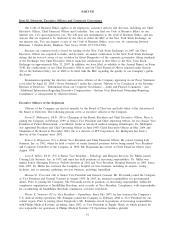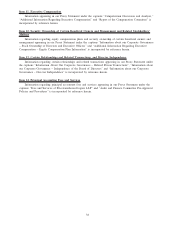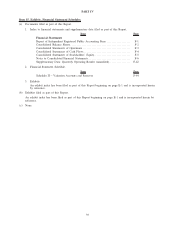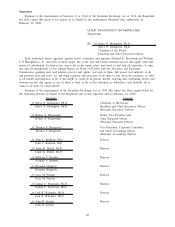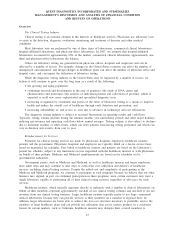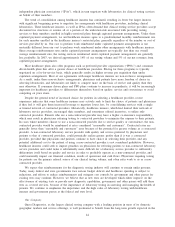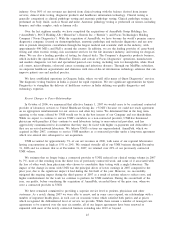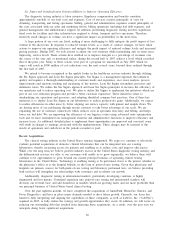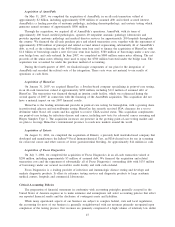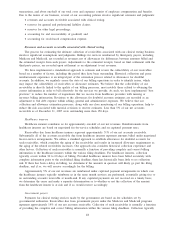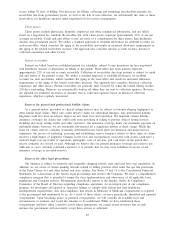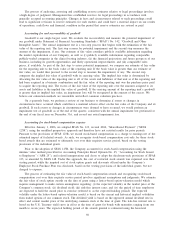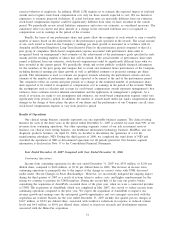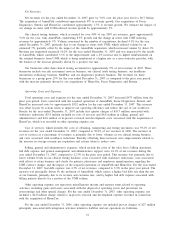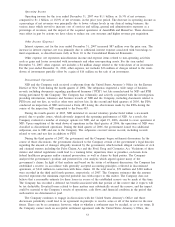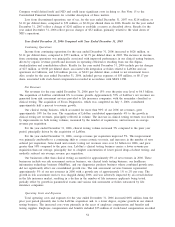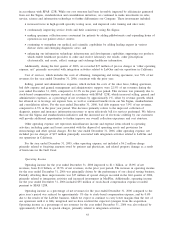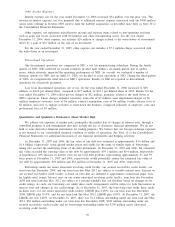Quest Diagnostics 2007 Annual Report Download - page 55
Download and view the complete annual report
Please find page 55 of the 2007 Quest Diagnostics annual report below. You can navigate through the pages in the report by either clicking on the pages listed below, or by using the keyword search tool below to find specific information within the annual report.Six Sigma and Standardization Initiatives/Efforts to Improve Operating Efficiency
The diagnostic testing industry is labor intensive. Employee compensation and benefits constitute
approximately one-half of our total costs and expenses. Cost of services consists principally of costs for
obtaining, transporting and testing specimens. Selling, general and administrative expenses consist principally of
the costs associated with our sales and marketing efforts, billing operations (including bad debt expense), and
general management and administrative support. In addition, performing diagnostic testing involves significant
fixed costs for facilities and other infrastructure required to obtain, transport and test specimens. Therefore,
relatively small changes in volume can have a significant impact on profitability in the short-term.
A large portion of our costs are fixed, making it more challenging to fully mitigate the profit impact of lost
volume in the short term. In response to reduced volume levels, as a result of contract changes, we have taken
actions to improve our operating efficiency and mitigate the profit impact of reduced volume levels and increased
pricing pressure. During 2007, we took actions to adjust our cost structure while maintaining and, in some cases
improving, service levels. These actions have enabled us to improve margins as a percentage of revenues over
the course of the year and, as mentioned earlier, during the second half of 2007 achieve a level which exceeded
that of the prior year. Many of these actions were part of a program we announced in July 2007 which we
expect will result in $500 million of cost reductions over the next several years, beyond those realized through
the first half of 2007.
We intend to become recognized as the quality leader in the healthcare services industry through utilizing
the Six Sigma approach and Lean Six Sigma principles. Six Sigma is a management approach that enhances
quality and requires a thorough understanding of customer needs and experience, root cause analysis, process
improvements and rigorous tracking and measuring of key metrics. Lean Six Sigma streamlines processes and
eliminates waste. We utilize the Six Sigma approach and Lean Six Sigma principles to increase the efficiency of
our operations and to reduce operating cost. We plan to utilize Six Sigma to implement the initiatives which are
part of our cost reduction program and provide a better customer experience. These initiatives relate to
standardizing our operations and processes, and adopting identified company best practices. One of these key
initiatives is to deploy Lean Six Sigma in our laboratories to realize productivity gains. Additionally, we expect
to realize efficiencies in other areas by better aligning our service capacity with patient and sample flows. We
are driving more of our purchasing through master contracts to take better advantage of our scale. We are
expanding the use of customer connectivity which reduces costs in specimen data entry and billing, and helps
lower our bad debt. We are improving the efficiency of our logistics routes using advanced route optimization
tools and we have streamlined our management structure and administrative functions to improve efficiency and
increase focus. As additional detailed plans to implement these opportunities are approved and executed, some
will result in charges to earnings associated with the implementation. These charges may be material to the
results of operations and cash flows in the periods recorded or paid.
Recent Acquisitions
The clinical testing industry in the United States remains fragmented. We expect to continue to selectively
evaluate potential acquisitions of domestic clinical laboratories that can be integrated into our existing
laboratories, thereby increasing access for patients and enabling us to reduce costs and improve efficiencies.
While over the long term we believe positive industry factors in the United States diagnostic testing industry and
the differentiated services we offer to our customers will enable us to grow organically, we believe there will
continue to be opportunities to grow beyond our current principal business of operating clinical testing
laboratories in the United States. Technology is enabling testing to be performed closer to the patient, whether in
the physician’s office or at the hospital bedside, in the form of point-of-care testing. Given that physicians and
hospitals are primary sources for both point-of-care testing and laboratory performed tests, we believe providing
both services will strengthen our relationships with customers and accelerate our growth.
Additionally, diagnostic testing in international markets, particularly developing countries, is highly
fragmented and less mature. Continued expansion into point-of-care testing and international markets will
diversify our revenue base, and add businesses in markets which are growing faster and are more profitable than
our principal business of United States based clinical testing.
Over the past eighteen months, we have completed the acquisitions of AmeriPath, HemoCue, Enterix, and
Focus Diagnostics, and have in place major elements needed to drive future growth. Currently, our focus has
turned to fully integrating and aligning the capabilities of these companies, as well as LabOne, Inc. (“LabOne”),
acquired in 2005, to fully realize the synergy and growth opportunities they create. In addition, we will focus on
reducing our outstanding debt that resulted from financing these acquisitions. As a result, over the next year we
anticipate doing fewer significant acquisitions.
46



